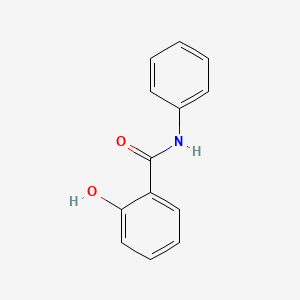D1088 | salicylanilide
| Toxicity | Dose | Time | Species | Model | Method | Action | Positive criterion | Reference |
|---|---|---|---|---|---|---|---|---|
| MEMBRANE POTENTIAL | 3.71±1.27 | human | qHTS-HepG2 | MMP assay | decrease | IC50 | 163 | |
| MEMBRANE POTENTIAL | 3.98 | human | HepG2 | MMP assay | decrease | IC50 | 163 | |
| MEMBRANE POTENTIAL | 29.09±12.18 | rat | hepatocytes | MMP assay | decrease | IC50 | 163 | |
| Pictogram | Signal | Statements | Precautionary Statement Codes |
|---|---|---|---|
  |
Warning |
Aggregated GHS information provided by 578 companies from 9 notifications to the ECHA C&L Inventory. Each notification may be associated with multiple companies. Reported as not meeting GHS hazard criteria by 41 of 578 companies. For more detailed information, please visit ECHA C&L website Of the 8 notification(s) provided by 537 of 578 companies with hazard statement code(s): H315 (100%): Causes skin irritation [Warning Skin corrosion/irritation] H319 (100%): Causes serious eye irritation [Warning Serious eye damage/eye irritation] H335 (99.81%): May cause respiratory irritation [Warning Specific target organ toxicity, single exposure Respiratory tract irritation] H400 (90.5%): Very toxic to aquatic life [Warning Hazardous to the aquatic environment, acute hazard] Information may vary between notifications depending on impurities, additives, and other factors. The percentage value in parenthesis indicates the notified classification ratio from companies that provide hazard codes. Only hazard codes with percentage values above 10% are shown. |
P261, P264, P271, P273, P280, P302+P352, P304+P340, P305+P351+P338, P312, P321, P332+P313, P337+P313, P362, P391, P403+P233, P405, and P501; (The corresponding statement to each P-code can be found at the GHS Classification page.) |
| Organism | Test type | Route | Dose (normalized dose) | Effect | Source |
|---|---|---|---|---|---|
| mouse | LD50 | oral | 2400mg/kg (2400mg/kg) | "Prehled Prumyslove Toxikologie; Organicke Latky," Marhold, J., Prague, Czechoslovakia, Avicenum, 1986Vol. -, Pg. 663, 1986. | |
| mouse | LD50 | intraperitoneal | > 500mg/kg (500mg/kg) | Farmaco. Vol. 44, Pg. 465, 1989. | |
| (2-hydroxyphenyl)-N-benzamide | 2-Hydroxy-N-phenyl-benzamide | 2-Hydroxy-N-phenylbenzamide |
| 2-Hydroxy-N-phenylbenzamide (1) | 2-Hydroxybenzanilide | 2-N-Phenylcarboxamidophenol |
| 2-Phenylaminocarbonylphenol | 4-12-00-00906 (Beilstein Handbook Reference) | 87-17-2 |
| AB00053159_10 | AB00053159_11 | ACMC-209qib |
| AI3-08114 | AK112784 | AKOS000119673 |
| ANW-38625 | ASK | Anilid kyseliny salicylove |
| Anilid kyseliny salicylove [Czech] | Ansadol | Aseptolan |
| BDBM234300 | BIM-0016643.P001 | BRD-K83036479-001-04-3 |
| BRN 1108135 | Benzamide, 2-hydroxy-N-phenyl- | C18915 |
| CAS-87-17-2 | CBMicro_016731 | CCG-5616 |
| CHEBI:239133 | CHEMBL82970 | CS-7965 |
| CTK3J0347 | Cambridge id 5305868 | Caswell No. 730 |
| DSSTox_CID_1784 | DSSTox_GSID_21784 | DSSTox_RID_76325 |
| DTXSID7021784 | DivK1c_007031 | EINECS 201-727-8 |
| EPA Pesticide Chemical Code 077407 | FT-0690167 | FT-0690183 |
| HMS2091A21 | HMS2401B23 | HMS3652N07 |
| HY-B1408 | Hyanilid | InChI=1/C13H11NO2/c15-12-9-5-4-8-11(12)13(16)14-10-6-2-1-3-7-10/h1-9,15H,(H,14,16 |
| KBio1_001975 | KS-0000172L | KSC490G4P |
| LHP8NEY345 | LS-144182 | MCULE-5347120160 |
| MFCD00002212 | MLS000105638 | N-Phenylsalicylamide |
| NCGC00076924-01 | NCGC00257535-01 | NE10154 |
| NSC 14881 | NSC-14881 | NSC-755836 |
| NSC14881 | NSC755836 | Oprea1_853375 |
| Pharmakon1600-00300618 | PubChem22916 | Q3469751 |
| RTR-031112 | S0007 | S359 |
| SALICYLANILIDE | SBB056703 | SBI-0016643.P004 |
| SCHEMBL14051034 | SCHEMBL152221 | SLI; |
| SMR000102616 | ST24022263 | ST50308512 |
| STL477629 | SW219188-1 | Salicylanilid |
| Salicylanilide [NF XIII] | Salicylanilide [NF] | Salicylanilide, 98% |
| Salicylic acid anilide | Salifebrin | Salinide |
| Salinidol | Salnide | Sherstat SLN |
| Shirlan | Shirlan (VAN) | Shirlan AG |
| Shirlan Extra | SpecPlus_000935 | Spectrum5_000937 |
| TR-031112 | TRA0061215 | Tox21_301301 |
| UNII-LHP8NEY345 | W-104040 | WKEDVNSFRWHDNR-UHFFFAOYSA-N |
| WLN: QR BVMR | WR 10019 | WR10019 |
| Z68084595 | ZINC2057 | o-Hydroxybenzanilide |
| s4187 |

